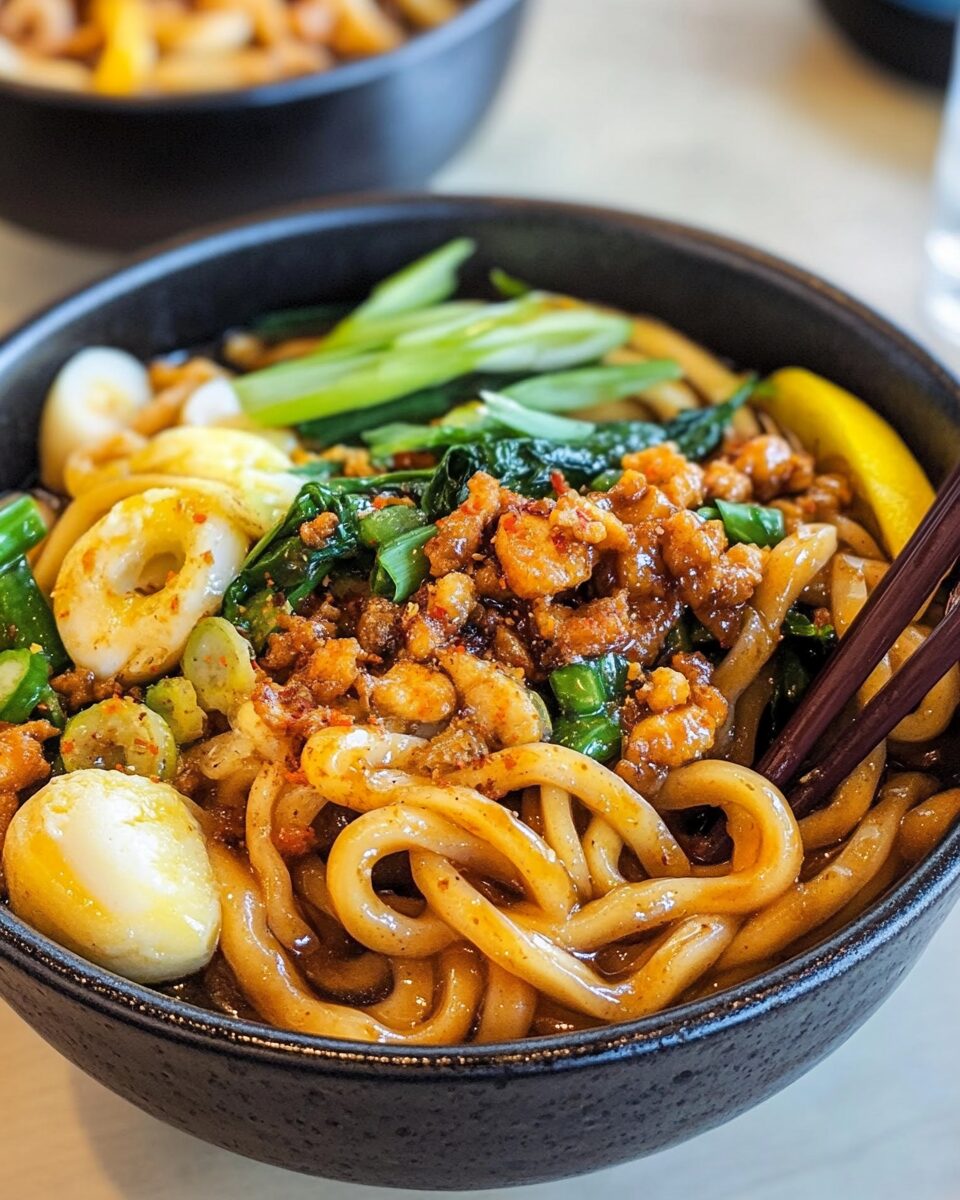The beauty of Yaki Udon lies in its versatility and speed. Thick, chewy udon noodles are stir-fried with savory sauce, tender vegetables, and your choice of protein—perfect for those busy nights when you want a comforting, flavorful meal in minutes.
This recipe highlights how simple ingredients can come together to make something exceptional. The umami-rich sauce coats each strand of noodle, while the fresh veggies add a satisfying crunch. Whether you’re cooking for yourself or serving a crowd, this dish never disappoints.
Full recipe:
Ingredients:
-
2 packets (13 oz total) udon noodles (vacuum packed)
-
2½ cups stir fry vegetables (e.g. mushrooms, bok choy, onions)
-
2 stalks scallions, cut 2 inches long
-
½ lb ground meat (chicken, beef, pork, turkey, or shrimp)
-
1 tablespoon avocado oil
For the Sauce:
-
2½ tablespoons dark soy sauce
-
2 tablespoons oyster sauce
-
1 tablespoon mirin
-
2 teaspoons brown sugar
-
½ teaspoon rice wine vinegar
Directions:
-
Prepare the sauce by mixing all ingredients in a small bowl. Set aside.
-
Remove udon noodles from their packaging and place them in boiling water. Gently stir until separated and pliable, about 1–2 minutes. Drain and rinse under cold water. Drizzle lightly with oil if not using immediately.
-
Heat a pan over high heat and add avocado oil.
-
Add ground meat and stir fry until almost cooked through.
-
Add chopped vegetables and continue stir frying until meat is fully cooked and veggies are softened.
-
Add the cooked udon noodles, scallions, and sauce to the pan. Stir fry for 3 more minutes or until everything is evenly coated and heated through.
-
Serve hot and enjoy!
Prep Time: 10 minutes | Cooking Time: 5 minutes | Total Time: 15 minutes
Kcal: 344 kcal | Servings: 2
The History Behind Yaki Udon
The origin of yaki udon is relatively modern, believed to have been developed in post-World War II Japan. Udon noodles were more readily available than soba or ramen noodles in some regions, and home cooks began stir-frying them with leftover vegetables and soy-based sauces. The dish quickly spread throughout Japan and became a regional favorite in areas like Fukuoka, where it’s still served in its more traditional form.
Over time, it evolved into various versions that include seafood, pork, beef, tofu, and a wide range of seasonal vegetables. The key aspect that remained constant is the characteristic chewiness of udon noodles, which contrasts beautifully with the softness of cooked vegetables and the richness of the sauce.
Why Yaki Udon is a Go-To Weeknight Meal
What makes yaki udon a perfect go-to meal is its speed and flexibility. From fridge to table in about 15 to 20 minutes, it fits into the busiest schedules while still delivering on taste and satisfaction. Pre-cooked udon noodles, often found vacuum-sealed or frozen at Asian grocery stores, are a game-changer. They require minimal cooking and have the ideal chewy texture when stir-fried properly.
Moreover, it’s a fantastic way to use up leftovers. Got a half onion, a stray carrot, a handful of mushrooms, or a few slices of cooked meat sitting in your fridge? Toss them in. Yaki udon thrives on improvisation, which makes it not just a recipe but a cooking technique and flavor base you can return to again and again.
What Makes Udon Noodles Special
Udon noodles are thick wheat noodles made with three basic ingredients: wheat flour, water, and salt. The magic lies in their texture—soft yet bouncy, with a springy chew that holds up exceptionally well during stir-frying. Unlike thinner noodles, udon doesn’t turn mushy easily, making it ideal for high-heat cooking.
When cooked correctly (especially when using frozen udon), these noodles separate into glossy, slippery strands that absorb sauce wonderfully. Their mild flavor also acts as a perfect canvas for rich sauces, umami flavors, and hearty toppings.
The Sauce: Where the Umami Lives
One of the stars of yaki udon is the sauce—a simple yet flavorful blend that often includes soy sauce, oyster sauce, mirin, a touch of sugar, and a splash of rice vinegar. This combination delivers the signature umami punch that’s essential to Japanese stir-fries. The balance of salty, sweet, and acidic components ensures that each bite is deeply savory without being overpowering.
This sauce can be tweaked depending on dietary needs or preferences. For example, vegetarians can swap oyster sauce for a mushroom-based alternative or hoisin sauce, while those who prefer a spicier kick can add chili oil or sriracha.
Protein Choices: Endless Possibilities
Yaki udon welcomes nearly any source of protein, which means it can suit virtually any diet. Ground chicken is often used for its light, lean quality, but beef, pork, turkey, shrimp, or even scrambled tofu all work beautifully. The key is to cook the protein until it’s nearly done before adding the vegetables and noodles, so everything finishes together in a cohesive dish.
The protein you choose also changes the flavor profile subtly—chicken keeps it mild and clean, beef makes it richer, shrimp adds a briny sweetness, and tofu absorbs sauce like a sponge, giving vegetarians a satisfying plant-based version.
Vegetables That Pair Well with Udon
Yaki udon doesn’t follow rigid rules when it comes to veggies. Common choices include onions, carrots, mushrooms, bok choy, cabbage, zucchini, and snap peas. What matters most is cutting the vegetables into similar sizes so they cook evenly during the quick stir-fry process.
Mushrooms add an earthy depth, leafy greens like bok choy or spinach lend freshness, while root vegetables like carrots and onions bring natural sweetness that balances the savory sauce.
In terms of technique, vegetables should be stir-fried on high heat so they stay slightly crisp and vibrant. Overcooking can lead to soggy textures, which dull the contrast that makes this dish so enjoyable.
Cooking Techniques & Pro Tips
To get the most out of yaki udon, there are a few pro tips that elevate it from good to restaurant-quality:
-
Use high heat: A hot pan ensures quick caramelization, especially for meats and vegetables.
-
Prep everything in advance: The stir-fry moves fast, so have all ingredients ready to go before the heat turns on.
-
Avoid overcrowding the pan: Cook in batches if necessary to avoid steaming the ingredients instead of searing them.
-
Don’t overcook the noodles: Udon noodles are already pre-cooked, so they just need to be loosened in hot water and tossed with the sauce. Overcooking them can lead to a mushy texture.
Frozen udon noodles are actually preferred by many chefs and food bloggers. When blanched briefly in boiling water, they separate beautifully and retain that signature chewiness.
Make It Your Own
The beauty of yaki udon is that it’s more of a method than a fixed recipe. Once you understand the basic components—noodles, protein, veggies, sauce—you can endlessly customize it to suit the seasons, your mood, or your pantry.
Want to make it vegan? Use tofu and mushroom-based sauces.
Going gluten-free? Substitute tamari or gluten-free soy sauce and rice noodles (though the texture will change).
Trying to cut calories? Use more veggies and lean protein, and cut back slightly on oil or sugar in the sauce.
Yaki udon is a dish that evolves with you. Whether you’re feeding picky eaters, cooking for two, or meal-prepping for the week, it’s one of those dishes that never fails.
Health & Nutrition Highlights
Although it’s considered comfort food, yaki udon can absolutely be part of a healthy diet. A single serving delivers balanced nutrition with carbohydrates (from noodles), protein (from meat or tofu), and plenty of fiber and micronutrients from vegetables.
Using lean meat and moderate oil keeps the fat content in check, while the inclusion of fermented sauces like soy and oyster sauce can provide small amounts of probiotics and trace minerals.
It’s important to watch sodium levels, especially with multiple sauces in play, but this can be adjusted by using reduced-sodium soy sauce or diluting the sauce mix with water or broth.
Storage and Reheating
Yaki udon makes excellent leftovers. Store it in an airtight container in the fridge for up to 3 days. When reheating, a quick toss in a hot skillet with a splash of water or sauce will revive the noodles and keep them from drying out.
Unlike some pasta dishes that get soggy or lose flavor, yaki udon often tastes even better the next day as the noodles continue to absorb the sauce. It’s a great make-ahead meal for busy weekdays or packed lunches.
Conclusion
Yaki Udon is the ultimate one-pan dish—hearty, flexible, quick to make, and loaded with flavor. Its balance of textures and umami-rich taste makes it a reliable favorite, whether you’re new to cooking or a seasoned home chef.
What truly makes it special is its adaptability. You can personalize it endlessly, switch up the sauce, change the protein, go light or indulgent—whatever suits your mood. And with minimal prep and cook time, it delivers a satisfying, restaurant-quality experience at home.
This humble stir-fried noodle dish proves that you don’t need complicated ingredients or long cooking hours to make something incredibly delicious. Keep udon noodles in your pantry or freezer, and you’ll always be just minutes away from a warm, comforting, and customizable meal.






